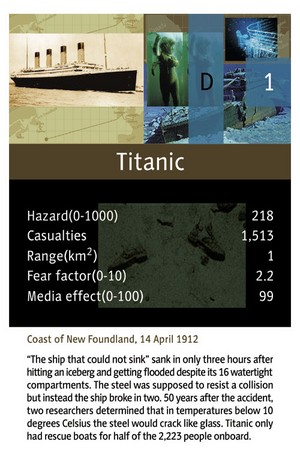|

“The ship that could not sink” sank on its maiden journey from Liverpool to New York. The ship was 269 meters from bow to stow, weighed 46,000 gross tons and carried 2,220 persons. It had been proclaimed unsinkable because of its 16 watertight compartments.
Titanic had received warnings of icebergs in the extraordinarily cold waters but Captain Edward J. Smith continued sailing at high speed. Shortly before midnight Titanic hit an iceberg. Mr. Smith ordered the watertight compartments closed, but it was futile since the iceberg had made a huge crack from which masses of water entered the ship.
25 minutes after the collision the captain sent the first SOS, which unfortunately was not received by the nearby ship California because of a radio defect. The passengers ran for the lifeboats and two hours after the collision the ship broke in two and sank. Three hours later the Carpathia arrived and saved the surviving passengers floating around in lifeboats.
Numerous films and books have portrayed the drama that took place the night of the 14 April. The astonishment of the passengers clad in furs and diamonds on the sloping deck, the orchestra that continued playing while the ship went down and the scream of drowning people.
Of the 2,220 persons on board 1,513 died, partly due to the fact that the ship did not have life boats for half the passengers, and the lifeboats that were used were not even full.
For almost 50 years the official explanation that Titanic sank because it had hit an iceberg was held to be true. But in 1963 two researchers revealed a theory, which they had worked on for 15 years, called the Nil Ductility Transition.
The study showed that whereas we normally would expect steel to stretch between 20 percent and 40 percent of its original length before it breaks, the steel on Titanic cracked in a brittle manner, like glass, when it hit the iceberg. The researchers found out that this only happens when the steel is below 10 degrees Celcius.
In the period after the Titanic US Government built 5,000 warships with the same fundamental flaw, whereof 1,000 had significant failures. Symptoms of this phenomenon had shown various times, but engineers were reluctant to investigate the cause.
Comment this page
 
Links and references:
Information and maps of the wreck:
http://www.titanic.com/
Biographies of passengers and crewmembers:
http://www.encyclopedia-titanica.org/index.php
Theory of Nil Ductility Transition:
http://www.disastercity.com/titanic/index.shtml
|

|
|



